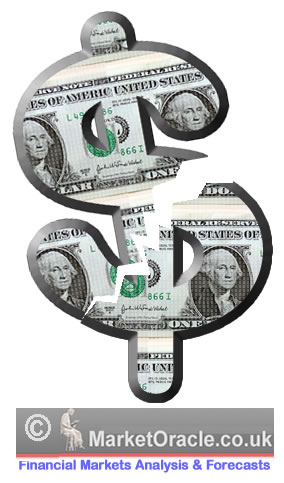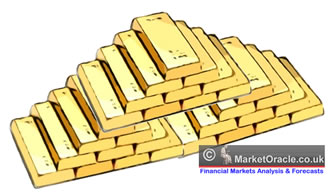$700 Billion Printing of Bailout Monopoly Money, Hedge Your Wealth!
Interest-Rates / Fiat Currency Oct 05, 2008 - 05:13 PM GMT Larry Edelson writes: If you think the biggest cost of the $700-billion bailout package is going to be higher taxes down the road, you're wrong.
Larry Edelson writes: If you think the biggest cost of the $700-billion bailout package is going to be higher taxes down the road, you're wrong.
The biggest cost is going to be the sheer destruction of the purchasing power of your money, an outright devaluation of the dollar that's going to occur, no matter what.
Don't get me wrong. I am not against the bailout package. It had to be done. We can debate free market philosophy for the next 100 years. We can debate the details of the package, too. But in the end none of that matters.
Because if Washington didn't act on this crisis, if they let AIG, WaMu, and others fail, the alternative — a deflationary depression several times worse than the Great Depression — would be a lot more painful, destroy a lot more lives and families, and take many more years to recover from.

So for now let's put all the philosophical debate aside and discuss this crisis in practical terms.
Where's the money going to come from?
Washington doesn't have $700 billion. Nor did it have the $592 billion it's already shelled out since August of last year, when the crisis began.
In fact, the U.S. government was broke before this bailout package. Now, it's even more broke.
So the money has to be borrowed from the public. Yet again. From investors in this country and from other countries. By issuing loads more government notes and bonds. Loads more IOUs.

Right now, it seems like investors around the world still have enough faith in the U.S. government to lend it most of the $700 billion. But it remains to be seen what interest rates they'll want to receive.
So we should be able to borrow most of the money for the bailout package.
And what about the amount that the public isn't willing to lend to the Treasury? No problem there either. The Federal Reserve will just print up the balance.
You see, the ultimate source of all money in the U.S. is either debt, or monopoly money created by the Federal Reserve. Or some combination of the two.
Either way, it's not real money. It's fictitious money. It's nothing but a bunch of IOUs and electronic credits and debits.
It's nothing more than a promise to pay you something of value. If you wait around long enough to get paid.
So we have that settled. We'll be able to borrow the money, or print it up. Either way, it's clear: The U.S. government, already in hock past its eyeballs, has to go even deeper in debt. A lot deeper.
So the next question is ...
What's the $700 billion really going to cost us?
No one knows for sure. But I'm going to take some guesses here.
First, if you buy the line that the Treasury is aiming to make money on the bailout, on behalf of the taxpayers — you and me — think again.
Since real estate prices were the trigger behind the losses, it's safe to assume that if the Treasury is going to make us any money on this deal then the assets underlying all the losses to begin with will need to somehow rise in value for us to make a profit.
That means property prices are going to have to regain all they've lost, and then some, for there to be a profit on that $700-billion investment.
I repeat: Property prices are going to have to regain all the value they've lost, and then some, for the Treasury to show us a profit on this $700-billion investment.
That's simply not going to happen. Not in my lifetime. Property prices might bottom out and start moving back up. But property values are not going to exceed their previous peak in my lifetime or likely yours.
Oh, and keep in mind, it's not really $700 billion. You have to add in the $592 billion the Fed and the Treasury already pumped into the economy prior to this bailout package. So the total so far is $1.29 trillion.
Second, there's the interest expense on all the IOUs that will have to be issued.
Let's take the total so far, the $1.29 trillion. Apply a conservative 5% interest rate the government is going to have to pay to borrow the money.
That's another $64 billion per year in interest expense costs. Compounded over 5 years, that's over $350 billion. 10 years, $807 billion.
Where's that money going to come from?
And if we're to profit from the bailout, that just means real estate prices not only have to get back to their previous peak, they have to exceed that peak by the amount of the interest expense that has to be paid to show a profit.
More proof we're not going to profit.
Third, raising taxes isn't going to help, either. There's no way the economy can handle higher tax burdens right now. And even if it could ...
Recouping part of the $1.29 trillion (ignoring the interest expense cost) through taxes is not a profit for the taxpayer. It's a burden. A cost.
So I ask you again, where's the profit potential for the U.S. taxpayer?
Answer: There will not be any profits. Period.
So the real cost of this bailout will be at least $1.29 trillion. And if real estate prices don't stabilize soon, the cost could easily mushroom to $1.5 trillion. Or $2 trillion. Perhaps even more. Not counting the interest expense!
And again, how's it going to be paid for?

The one and only answer: By a substantial devaluation of the U.S. dollar. By inflating it away. By eventually raising asset prices fictitiously through inflation, through more smoke and mirrors, via an eventual massive dollar devaluation.
In fact, there's precedent for it: The Great Depression only ended after Roosevelt devalued the U.S. dollar in January 1934 by raising its exchange rate with gold from $20.67 to $35.00. That was a de facto 69% devaluation of the dollar.
The same thing is going to have to happen this time around. Only you won't see any President, or anyone in Congress or the Fed actually coming out and saying the dollar needs to be devalued.
They won't have to. The markets will do it themselves. Notwithstanding an occasional knee-jerk rally in the buck, the dollar is toast. No ifs, ands, or buts about it.
Already, some measures of money supply, the ultimate source of devaluation of a currency and inflation in the economy, show money growth running at an annual rate of more than 14%.
And in the last two weeks, that rate has exploded even higher, to an annualized growth rate of, get this — over 200%!
There is no way that kind of monetary growth can be anything but inflationary.
So What Can You Do To Protect Your Wealth?
Now, more than ever before, you must keep in focus my two-pronged approach to protecting — and increasing — your net worth:
First, no matter what, keep the majority of your money LIQUID!
Don't get stuck in illiquid investments right now, especially real estate.
Also, continue to steer clear of long-term government, municipal, and corporate bonds.
Ignore the talk that interest rates on these instruments will decline. They may do so in the short-term, but with the Fed pumping out money like crazy, it's only a matter of time before bonds get hit hard again, and long-term rates start climbing.
In my opinion, as well as Martin's, treasury-only money markets are the best place to hold the majority of your keep-safe funds. Forget about the yield. The most important thing right now is making sure you get back your money.
It may seem like a contradiction to invest in Treasury bills with the government so dead broke and having to borrow so much more money. But lending your money to the government for a year or less is a heck of a lot safer than lending it to them for 10, 20 or 30 years, where you're sure to lose out to inflation.
Second, hedge the value of your money and simultaneously position yourself for profits.
The best way to do both: Seek out tangible assets that thrive when the dollar is sinking and inflation is rising, especially gold.

Gold is the ultimate safe haven, the world's only true form of money.
If you've been following my recommendations here, especially my flash alert of September 16, then you're all set, with up to 25% of your liquid net worth in various gold investments.
Gold is up 17% since I issued that flash alert, just two weeks ago. What's more, the precious yellow metal is up more than 131% since I first recommended it in my Real Wealth Report . And more than 250% since I started recommending it at Weiss Research.
Hold that gold, or you'll be sorry.
Also consider other hard, tangible assets with intrinsic value. Such as oil ... food ... and other natural resources.
Some of these markets have taken hits recently. But long term, they remain in strong, enduring bull markets.
Best wishes,
Larry
P.S. For my latest recommendations, be sure to subscribe to Real Wealth Report . For just $99 a year, for 12 monthly issues, all recommendations, flash alerts, my website, and more.
It will be the best $99 you've ever spent !
This investment news is brought to you by Money and Markets . Money and Markets is a free daily investment newsletter from Martin D. Weiss and Weiss Research analysts offering the latest investing news and financial insights for the stock market, including tips and advice on investing in gold, energy and oil. Dr. Weiss is a leader in the fields of investing, interest rates, financial safety and economic forecasting. To view archives or subscribe, visit http://www.moneyandmarkets.com .
Money and Markets Archive |
© 2005-2022 http://www.MarketOracle.co.uk - The Market Oracle is a FREE Daily Financial Markets Analysis & Forecasting online publication.



